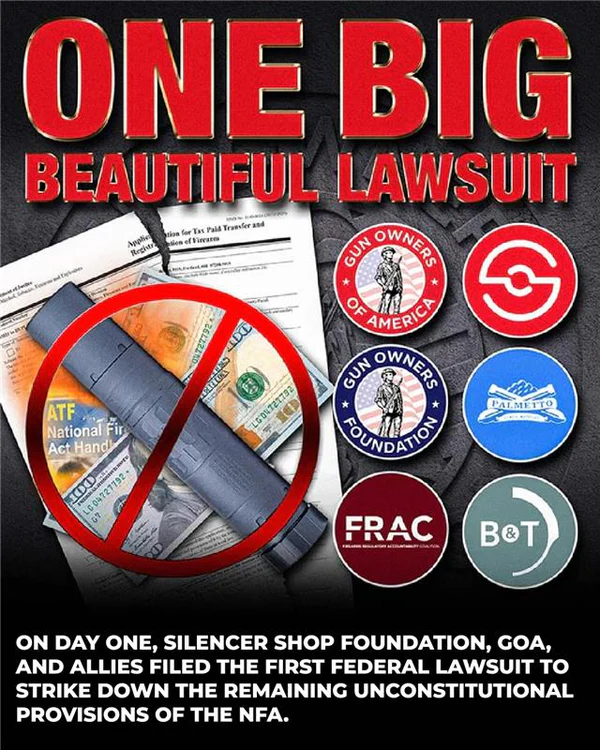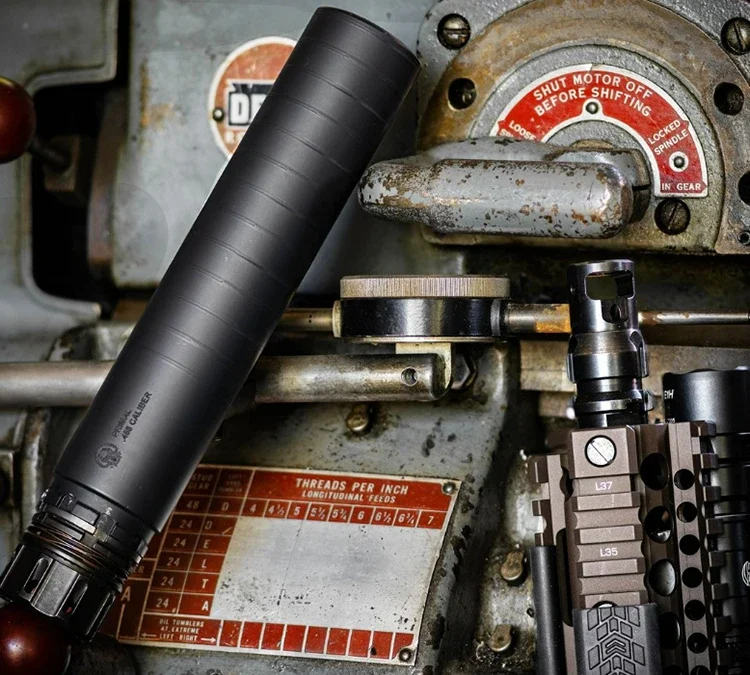For nearly a century, the National Firearms Act of 1934 has done more to stifle suppressor innovation than any other regulation in American history. By lumping suppressors in with machine guns and short-barreled rifles, and slapping a $200 tax stamp on each unit, the NFA crippled civilian development for decades.
Even today, manufacturers face restrictions on serialized parts and complex remanufacture laws that slow progress and increase costs. But with the 2025 repeal of the suppressor tax stamp set to take effect in 2026, the industry stands at a turning point. The Silencer Shop Foundation is working to ensure that this long-overdue reform fuels innovation, expands access, and finally brings American suppressor design into the modern era.
The NFA’s Chilling Effect on Suppressor Innovation
A Brief Historical Perspective
The first commercial suppressor, patented by Hiram Percy Maxim in 1909, was a simple yet revolutionary device that reduced muzzle blast and protected shooters’ hearing. But just 25 years later, the National Firearms Act of 1934 changed everything. By classifying suppressors alongside machine guns and imposing a $200 tax stamp, equivalent to several thousand dollars today, the NFA effectively erased the civilian market overnight.
The result was predictable: no demand, no innovation. For decades, suppressor development stagnated as manufacturers focused on military contracts while civilian technology remained frozen in time.
1934–1970s: A Half-Century of Stagnation
With limited civilian ownership and heavy federal oversight, companies had little reason to invest in advanced designs, lighter materials, or modular construction. The NFA redefined suppressors as prohibited devices rather than consumer products, and that mindset became deeply entrenched across the industry.
1980s–Present: A Quiet Resurgence Still Under Restraint
By the 1980s, new materials like titanium and Inconel, combined with CNC machining and 3D printing, finally revived innovation. Today’s suppressors are lighter, more efficient, and far more durable than their predecessors.
Yet every step forward still battles regulatory drag: serialized components, complex transfer rules, and restrictions that treat each suppressor as a Title II firearm. Every new design iteration requires navigating paperwork, tax stamps, and ATF interpretation, a costly and time-consuming process that limits experimentation and slows the speed to market.
How Innovation Remains Constrained
Even in 2025, the suppressor market operates under Depression-era rules that continue to slow development and limit accessibility.
The Tax-Stamp and Registration Burden
Although Congress has voted to eliminate the $200 tax stamp effective January 1, 2026, suppressors remain subject to the same registration, fingerprinting, and transfer processes.
For manufacturers, every serialized unit must be tracked like a firearm. That means extra overhead, slower R&D cycles, and reduced flexibility for limited production runs or prototype testing.
Serialized Parts and Remanufacture Ambiguity
Modern suppressors often feature modular components, including end caps, mounts, and baffle stacks. However, under the current NFA interpretation, replacing key parts can risk creating a “new suppressor,” which would require new paperwork. This gray area discourages innovation and user-serviceable designs that could otherwise make suppressors safer, more customizable, and more affordable.
Multi-caliber suppressors face similar challenges. Each design change, whether length, bore size, or baffle design, can trigger additional regulatory review. Implementing state-level restrictions adds a compliance maze that slows even incremental progress for companies.
Market Size and Adoption
Regulatory barriers have also suppressed demand. Fewer buyers mean smaller R&D budgets, which forces manufacturers to focus on safe, predictable models instead of experimenting with new technologies. The result: slower evolution and higher prices for consumers.
Even with eForms streamlining the approval process, every suppressor sale still requires federal review. That friction alone limits volume and, in turn, the economies of scale that drive innovation in other segments of the firearms industry.
Why Innovation Matters and What’s Been Held Back
What Could Be Achieved with Fewer Constraints
- Faster development cycles: Without lengthy approval processes, companies could test, refine, and launch new suppressors in months, not years.
- Broader affordability: Reduced compliance costs would make entry-level suppressors more accessible, expanding ownership and funding further R&D.
- User-serviceable modularity: Clear rules around parts swaps would empower shooters to maintain or upgrade their own suppressors safely.
- Cross-platform advancement: From rimfire and precision rifles to AR platforms, innovation would accelerate across every shooting discipline.
What’s Been Held Back
Because every suppressor is serialized and heavily regulated, companies can’t treat them like optics or barrels with incremental product lines. Modular suppressors exist, but only within cautious design limits. User-swappable baffles, interchangeable cores, or cross-caliber systems remain rare, not due to a lack of ability, but rather due to fear of regulatory misclassification.
This compliance-first environment diverts engineering resources away from design and toward paperwork. The cost of innovation rises while consumer options remain artificially limited.
The 2025–2026 Reform Landscape
Key Legislative Changes
In 2025, Congress passed legislation eliminating the $200 federal tax on suppressors, short-barreled rifles, shotguns, and other NFA-regulated items. The law takes effect January 1, 2026, removing one of the longest-standing financial barriers to suppressor ownership.
While registration and serial-number requirements remain, this marks the most significant shift in suppressor regulation in nearly a century. Removing the tax stamp doesn’t end the NFA, but it signals that reform momentum is real.
Implications for Innovation
- Lower cost barriers: More buyers mean more funding for new designs.
- Faster ROI: Manufacturers can take bigger R&D risks knowing that the consumer base will grow.
- Encouraged modularity: Reduced regulatory pressure will make it easier to pursue advanced, user-serviceable designs.
- New market entrants: Small and mid-sized companies can finally compete without being crushed by compliance costs.
Challenges That Remain
- Lingering bureaucracy: Registration, background checks, and transfer delays still limit agility.
- Regulatory uncertainty: The ATF’s vague stance on modularity and remanufacture needs clear definition.
- Market education: Even with deregulation, consumer awareness and dealer training must expand to sustain growth.
The Silencer Shop Foundation: Advocacy Meets Innovation
As the industry transitions into a post-tax-stamp era, the Silencer Shop Foundation is taking point on responsible reform. Its mission goes beyond politics; it’s about clearing the path for technological progress.

Key initiatives include:
- Advocating full NFA reform: Supporting efforts to remove suppressors entirely from the NFA classification, streamlining ownership while maintaining background checks.
- Funding next-generation research: Investing in R&D for lightweight alloys, additive manufacturing, and low-backpressure designs that reduce sound and recoil without sacrificing performance.
- Building academic and industry partnerships: Working with engineering programs and small manufacturers to accelerate innovation once regulatory barriers fall.
- Educating the public: Promoting responsible ownership, safety, and the real-world benefits of suppression technology for hearing protection and recoil mitigation.
Final Thoughts
For 90 years, the NFA has shackled American suppressor innovation through taxes, serialization, and bureaucracy. However, the tide is turning. The elimination of the tax stamp in 2026 marks a historic step toward normalizing suppressors as what they truly are: safety tools, not contraband.
Real progress will depend on what comes next. Without continued reform, manufacturers will remain bound by outdated laws that slow the pace of design and limit access for responsible gun owners.
That’s why the Silencer Shop Foundation’s role is so critical. By leading the charge on education, research, and advocacy, it ensures that the next generation of suppressor technology is shaped not by government restriction, but by American innovation.
Read more about the Silencer Shop Foundation on TTAG:
Read the full article here


